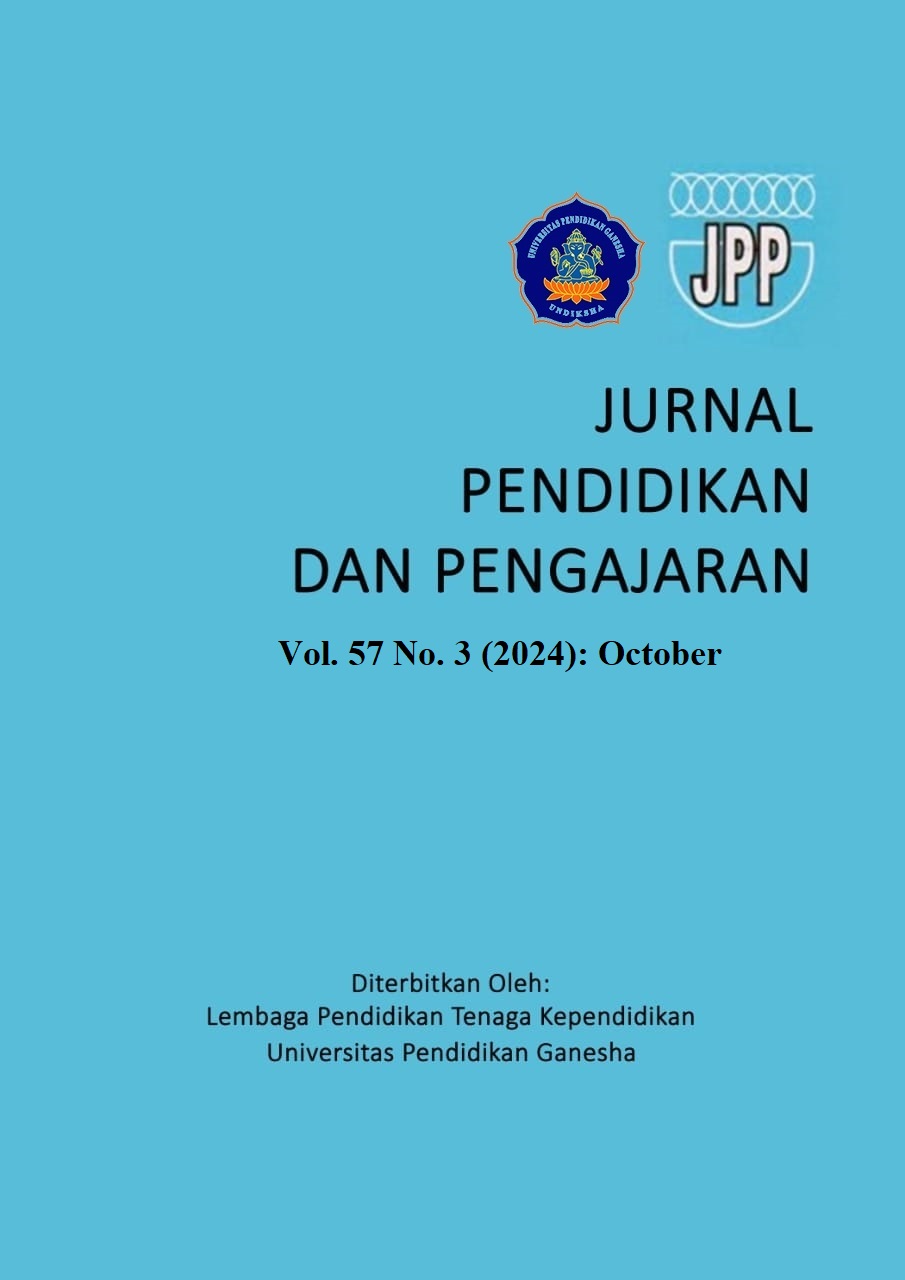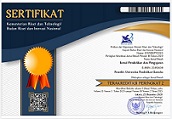Problem Solving Learning with Drawing a Diagram Strategy to Improve Mathematical Reflective Thinking Skills
DOI:
https://doi.org/10.23887/jpp.v57i3.80361Keywords:
Problem Solving, Drawing A Diagram, Mathematical Reflective Thinking SkillsAbstract
Mathematics learning in schools today tends to be limited to formula memorization and routine exercises, leading to a lack of cognitive engagement of students. Learning innovations are needed that can develop mathematical reflective thinking skills. This study aims to determine the difference in the improvement of mathematical reflective thinking skills between students who are taught using problem-solving strategies by drawing diagrams and students who are taught by the expository method. This study used a quasi-experiment design with a Randomized Posttest Only Control Group Design, involving a population of 288 grade VIII students. Two groups were randomly selected from clusters, each consisting of 36 students; one group as an experiment and the other as a control. Data were collected through a written test of mathematical reflective thinking ability and analyzed using an independent sample t-test to see significant differences between groups. The results showed that students who were taught with diagramming strategies experienced a significant improvement in mathematical reflective thinking skills compared to the control group. This study concludes that the diagramming strategy is effective in improving mathematical reflective thinking skills and helping students in solving problems systematically.
References
Andini, S. R., Putri, V. M., Devi, M. Y., & Erita, Y. (2021). Mendesain Pembelajaran PKn dan IPS yang Inovatif dan Kreatif dengan Menggunakan Model Pembelajaran Pada Tingkat Sekolah Dasar. Jurnal Basicedu, 5(6), 5671–5681. https://doi.org/10.31004/basicedu.v5i6.1760.
Anggoro, A. F. D., Hendriana, H., & Yuliani, A. (2023). Structural Model Between Mathematical Reasoning and Mathematics Problem-Solving Abilities of Junior High School Students. Journal of Honai Math, 6(1), 71–75. https://doi.org/10.30862/jhm.v6i1.405.
Arib, M. F., Rahayu, M. S., Sidorj, R. A., & Afgani, M. W. (2024). Experimental Research Dalam Penelitian Pendidikan. Innovative: Journal Of Social Science Research, 4(1), 5497–5511. https://doi.org/10.31004/innovative.v4i1.8468.
Bone, E. K., Bouck, E. C., & Smith III, J. P. (2022). Using the VA Framework to Teach Algebra to Middle School Students With High-Incidence Disabilities. Journal of Special Education Technology, 37(3), 384–398. https://doi.org/10.1177/01626434211019388.
Djudin, T. (2020). An easy way to solve problems of physics by using metacognitive strategies: A Quasy-Experimental Study on Prospective teachers in Tanjungpura University-Indonesia. Journal of Teaching and Teacher Education, 8(1), 19–27. https://doi.org/10.12785/jtte/080103.
Evidiasari, S., Subanji, S., & Irawati, S. (2019). Students’ Spatial Reasoning in Solving Geometrical Transformation Problems. Indonesian Journal on Learning and Advanced Education (IJOLAE), 1(2), 38–51. https://doi.org/10.23917/ijolae.v1i2.8703.
Evita, E., Syahid, A., & Nurdin, N. (2019). Understanding Students’ Learning Outcomes Differences Through the Application of the Market Place Activity Type of Cooperative Learning Model and the Application of Conventional Learning Models. International Journal of Contemporary Islamic Education, 1(1), 67–85. https://doi.org/10.24239/ijcied.Vol1.Iss1.5.
Firmansyah, D. (2022). Teknik Pengambilan Sampel Umum dalam Metodologi Penelitian: Literature Review. Jurnal Ilmiah Pendidikan Holistik (JIPH), 1(2), 85–114. https://doi.org/10.55927/jiph.v1i2.937.
Grigg, S. J., & Benson, L. C. (2014). A coding scheme for analysing problem-solving processes of first-year engineering students. European Journal of Engineering Education, 39(6), 617–635. https://doi.org/10.1080/03043797.2014.895709.
Hasibuan, A. C. U., & Hakim, D. L. (2022). Kemampuan Pemecahan Masalah Matematis Siswa Dengan Tahapan Polya. Didactical Mathematics, 4(1), 156–162. https://doi.org/10.31949/dm.v4i1.2014.
Hayati, R., Fachrurazi, F., Karim, A., & Marzuki, M. (2022). Peningkatan Kemampuan Pemecahan Masalah menggunakan Model Problem Based Learning Berbantuan Video Pembelajaran Di Sekolah Dasar. Jurnal Absis: Jurnal Pendidikan Matematika Dan Matematika, 5(1), 621–629. https://doi.org/10.30606/absis.v5i1.1558.
Heideman, P. D., Flores, K. A., Sevier, L. M., & Trouton, K. E. (2017). Effectiveness and adoption of a drawing-to-learn study tool for recall and problem solving: Minute sketches with folded lists. CBE—Life Sciences Education, 16(2), ar28. https://doi.org/10.1187/cbe.16-03-0116.
Hendriana, H., Putra, H. D., & Hidayat, W. (2019). How to design teaching materials to improve the ability of mathematical reflective thinking of senior high school students in Indonesia? Eurasia Journal of Mathematics, Science and Technology Education, 15(12). https://doi.org/10.29333/ejmste/112033.
Huda, W. N., Suyitno, H., & Wiyanto, W. (2017). Analysis of Mathematical Problem Solving Abilities in Terms of Students’ Motivation and Learning Styles. Journal of Primary Education, 6(3), 209–217. https://doi.org/10.15294/jpe.v6i3.21069.
Jaenudin, J., Nindiasari, H., & Pamungkas, A. S. (2017). Analisis Kemampuan Berpikir Reflektif Matematis Siswa Ditinjau Dari Gaya Belajar. Prima: Jurnal Pendidikan Matematika, 1(1), 69–82. https://doi.org/10.31000/prima.v1i1.256.
Kholid, M. N., Swastika, A., Ishartono, N., Nurcahyo, A., Lam, T. T., Maharani, S., Ikram, M., Murniasih, T. R., Majid, M., Wijaya, A. P., & Pratiwi, E. (2022). Hierarchy of students’ reflective thinking levels in mathematical problem solving. Acta Scientiae, 24(6), 24–59. https://doi.org/10.17648/acta.scientiae.6883.
Krupa, E. E., Webel, C., & McManus, J. (2015). Undergraduate Students’ Knowledge of Algebra: Evaluating the Impact of Computer-based and Traditional Learning Environments. Primus, 25(1), 13–30. https://doi.org/10.1080/10511970.2014.897660.
Kurniawati, M., Purwaningsih, W. I., & Yuzianah, D. (2023). Analisis Kemampuan Berpikir Reflektif Siswa Climber dalam Menyelesaikan Soal Literasi Numerasi SMP. Didactical Mathematics, 5(2), 597–603. https://doi.org/10.31949/dm.v5i2.6678.
McNeill, N. J., Douglas, E. P., Koro‐Ljungberg, M., Therriault, D. J., & Krause, I. (2016). Undergraduate students’ beliefs about engineering problem solving. Journal of Engineering Education, 105(4), 560–584. https://doi.org/10.1002/jee.20150.
Mirlanda, E. P., Nindiasari, H., & Syamsuri, S. (2020). Pengaruh Pembelajaran Flipped Classroom Terhadap Kemampuan Penalaran Matematis Ditinjau Dari Gaya Kognitif Siswa. Prima: Jurnal Pendidikan Matematika, 4(1), 11–21. https://doi.org/10.31000/prima.v4i1.2081.
Ningrum, R. O. D., & Minarti, E. D. (2022). Analisis Kesalahan Siswa Dalam Menyelesaikan Soal Persamaan Linier Dua Variabel Di Smp Al-Mahmud Plus-Cililin. Jurnal Pembelajaran Matematika Inovatif, 5(1), 33–42. https://doi.org/10.22460/jpmi.v5i1.33-42.
Nirwana, N., Susanti, E., & Susanto, D. (2021). Pengaruh Penerapan Somatis, Auditori, Visual, dan Intelektual Terhadap Kemampuan Komunikasi Matematis Siswa. Ideas: Jurnal Pendidikan, Sosial, Dan Budaya, 7(4), 251–258. https://doi.org/10.32884/ideas.v7i4.451.
Nitte, Y. M., & Bulu, V. R. (2022). Pemetaan implementasi pendidikan karakter di sekolah dasar se-kota Kupang. Jurnal Kependidikan: Jurnal Hasil Penelitian Dan Kajian Kepustakaan Di Bidang Pendidikan, Pengajaran Dan Pembelajaran, 6(1), 38–47. https://doi.org/10.33394/jk.v6i1.2326.
Pradiarti, R. A. (2022). Kemampuan Pemecahan Masalah Matematis Siswa SMP ditinjau dari Gaya Kognitif. Mosharafa: Jurnal Pendidikan Matematika, 11(3), 379–390. https://doi.org/10.31980/mosharafa.v11i3.729.
Puspitasari, L., In’am, A., & Syaifuddin, M. (2018). Analysis of students’ creative thinking in solving arithmetic problems. International Electronic Journal of Mathematics Education, 14(1), 49–60. https://doi.org/10.12973/iejme/3962.
Putri, F., Muin, A., & Khairunnisa, K. (2020). Pengaruh Pendekatan Metakognitif Dan Kemampuan Awal Matematis Terhadap Kemampuan Berpikir Reflektif Matematis Siswa. ALGORITMA: Journal of Mathematics Education, 1(2), 134–145. https://doi.org/10.15408/ajme.v1i2.14074.
Rohman, M. A., Utami, R. E., & Indiati, I. (2021). Analisis Kemampuan Berpikir Kreatif Matematis Siswa Ditinjau dari Self Concept. Imajiner: Jurnal Matematika Dan Pendidikan Matematika, 3(2), 88–98. https://doi.org/10.26877/imajiner.v3i2.7243.
Sa’dijah, C., Kholid, M. N., Hidayanto, E., & Permadi, H. (2020). Reflective thinking characteristics: a study in the proficient mathematics prospective teachers. Infinity Journal, 9(2), 159–172. https://doi.org/10.22460/infinity.v9i2.p159-17242-6596/1783/1/012102.
Sa’diyah, U., Nizaruddin, N., & Muhtarom, M. (2020). Translasi Antar Representasi Matematis Visual Ke Verbal Dalam Memahami Konsep Pada Materi Spldv Ditinjau Dari Kemampuan Matematika Tinggi. Imajiner: Jurnal Matematika Dan Pendidikan Matematika, 2(4), 266–275. https://doi.org/10.26877/imajiner.v2i4.6122.
Siregar, A., Nasution, B. N., Sihotang, D. R. A., Arif, I. I., & Frisnoiry, S. (2023). Analisis Kesalahan dan Kesulitan Siswa Dalam Menyelesaikan Soal pada Materi Persamaan Trigonometri. Nautical : Jurnal Ilmiah Multidisiplin, 2(2), 114–118. https://doi.org/10.55904/nautical.v2i2.720.
Sumartini, T. S. (2016). Peningkatan Kemampuan Pemecahan Masalah Matematis Siswa melalui Pembelajaran Berbasis Masalah. Mosharafa: Jurnal Pendidikan Matematika, 5(2), 148–158. https://doi.org/10.31980/mosharafa.v5i2.391.
Sümen, Ö. Ö. (2023). Reflective Thinking in The Problem-Solving Process: A Model Proposal. Sakarya University Journal of Education, 13(1), 6–23. https://doi.org/10.19126/suje.970213.
Surya, E., & Syahputra, E. (2017). Improving High-Level Thinking Skills by Development of Learning PBL Approach on the Learning Mathematics for Senior High School Students. International Education Studies, 10(8), 12–20. https://doi.org/10.5539/ies.v10n8p12.
Tambunan, H. (2019). The Effectiveness of the Problem Solving Strategy and the Scientific Approach to Students’ Mathematical Capabilities in High Order Thinking Skills. International Electronic Journal of Mathematics Education, 14(2), 293–302. https://doi.org/10.29333/iejme/5715.
Ventistas, G., Ventista, O. M., & Tsani, P. (2024). The impact of realistic mathematics education on secondary school students’ problem-solving skills: a comparative evaluation study. Research in Mathematics Education, 8(1), 46–56. https://doi.org/10.1080/14794802.2024.2306633.
Yayuk, E., Purwanto, As’Ari, A. R., & Subanji. (2020). Primary school students’ creative thinking skills in mathematics problem solving. European Journal of Educational Research, 9(3), 1281–1295. https://doi.org/10.12973/eu-jer.9.3.1281.
Zulianto, R., & Budiarto, M. T. (2020). Kemampuan Translasi Representasi Matematis Siswa SMP Dalam Menyelesaikan Soal Kontekstual. JKPM (Jurnal Kajian Pendidikan Matematika), 5(2), 313. https://doi.org/10.30998/jkpm.v5i2.6442.
Downloads
Published
How to Cite
Issue
Section
License
Copyright (c) 2024 Yusuf Sodhiqin, Haryanto

This work is licensed under a Creative Commons Attribution-ShareAlike 4.0 International License.
Authors who publish with Jurnal Pendidikan dan Pengajaran agree to the following terms:- Authors retain copyright and grant the journal the right of first publication with the work simultaneously licensed under a Creative Commons Attribution License (CC BY-SA 4.0) that allows others to share the work with an acknowledgment of the work's authorship and initial publication in this journal
- Authors are able to enter into separate, additional contractual arrangements for the non-exclusive distribution of the journal's published version of the work (e.g., post it to an institutional repository or publish it in a book), with an acknowledgment of its initial publication in this journal.
- Authors are permitted and encouraged to post their work online (e.g., in institutional repositories or on their website) prior to and during the submission process, as it can lead to productive exchanges, as well as earlier and greater citation of published work. (See The Effect of Open Access)





